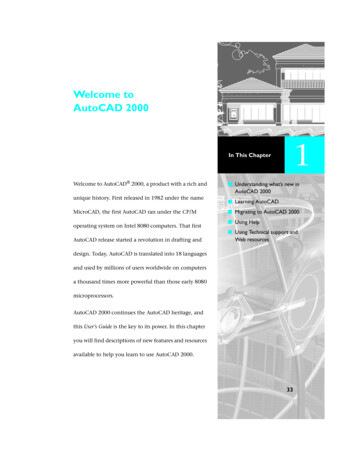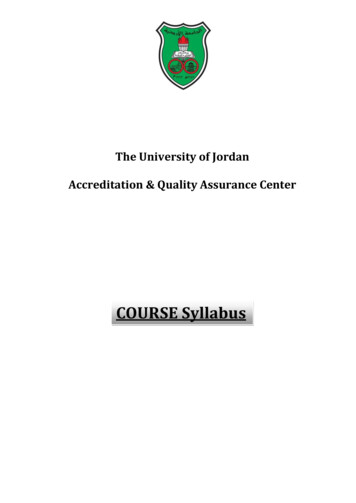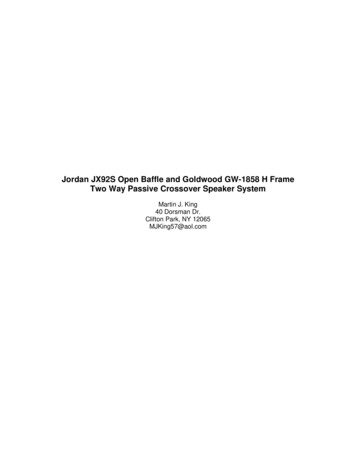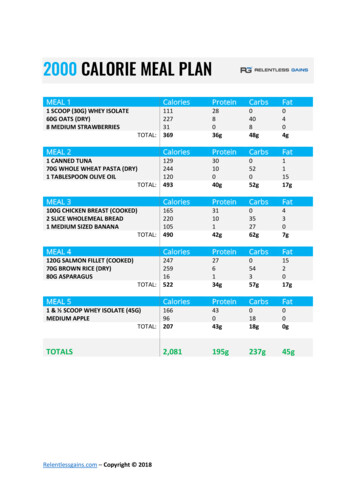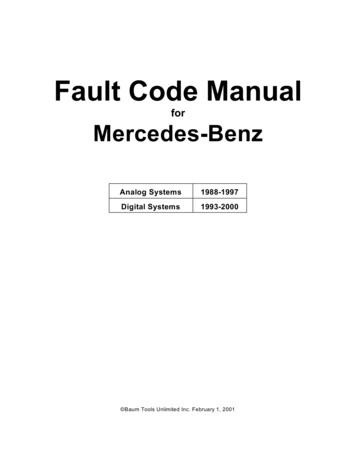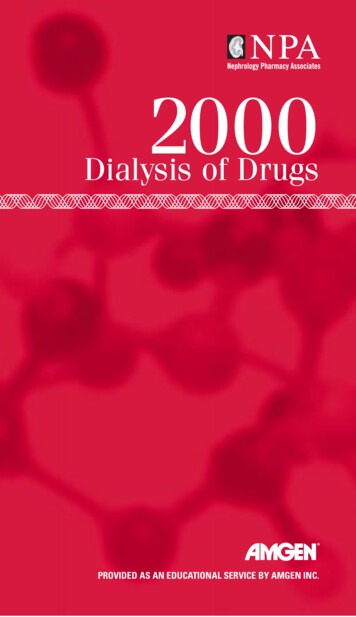
Transcription
2000Dialysis of DrugsPROVIDED AS AN EDUCATIONAL SERVICE BY AMGEN INC.
Dialysis of DrugsCurtis A. Johnson, PharmDMember, Board of DirectorsNephrology Pharmacy AssociatesAnn Arbor, MichiganandProfessor of Pharmacy and MedicineUniversity of Wisconsin-MadisonMadison, WisconsinWilliam D. Simmons, RPhSenior Clinical PharmacistDepartment of PharmacyUniversity of Wisconsin Hospital and ClinicsMadison, WisconsinSEE DISCLAIMER REGARDING USE OF THIS POCKET BOOKI DIALYSIS OF DRUGS2000
DISCLAIMER—These Dialysis of Drugs guidelinesare offered as a general summary of informationfor pharmacists and other medical professionals.Inappropriate administration of drugs may involveserious medical risks to the patient which canonly be identified by medical professionals.Depending on the circumstances, the risks canbe serious and can include severe injury,including death. These guidelines cannot identifymedical risks specific to an individual patient orrecommend patient treatment. These guidelinesare not to be used as a substitute for professionaltraining. The absence of typographical errors isnot guaranteed. Use of these guidelines indicatesacknowledgement that neither NephrologyPharmacy Associates, Inc. nor Amgen Inc. will beresponsible for any loss or injury, including death,sustained in connection with or as a result of theuse of these guidelines. Readers should consultthe complete information available in the packageinsert for each agent indicated before prescribingmedications.Guides such as this one can only draw frominformation available as of the date of publication.Neither Nephrology Pharmacy Associates, Inc. norAmgen Inc. is under any obligation to updateinformation contained herein. Future medicaladvances or product information may affect orchange the information provided. Pharmacists andother medical professionals using these guidelinesare responsible for monitoring ongoing medicaladvances relating to dialysis.Copyright 2000, Nephrology PharmacyAssociates, Inc. Printed in the U.S.A. All rightsreserved. This material may not be published,rewritten or redistributed.4SEE DISCLAIMER REGARDING USE OF THIS POCKET BOOK
I PREFACEPrefaceDrug removal during dialysis is frequently ofinterest to those caring for patients receivinghemodialysis or peritoneal dialysis. The extentof drug dialyzability determines whethersupplemental dosing is necessary during orfollowing dialysis. The accompanying tablehas been prepared as a reference regardingthe effect either form of dialysis may haveon drug clearance. This table should be usedas a general guideline.The drugs included in the table are parentdrugs. In some cases, these drugs are converted to pharmacologically active or toxicmetabolites for which little dialysis informationis known. When available, serum drugmeasurements may be appropriate for dosingindividual patients. In all cases, patients shouldbe monitored for clinical efficacy and toxicity.What DeterminesDrug Dialyzability?The extent to which a drug is affected bydialysis is determined primarily by severalphysicochemical characteristics of the drug,which are briefly described in the text thatfollows. These include molecular size, proteinbinding, volume of distribution, water solubility, and plasma clearance. In addition to theseproperties of the drug, technical aspects of thedialysis procedure may also determine theextent to which a drug is removed by dialysis.SEE DISCLAIMER REGARDING USE OF THIS POCKET BOOK5
Molecular WeightDialysis is dependent upon the use of a dialyticmembrane: either a synthetic membranewith fixed pore size, as in hemodialysis, or anaturally occurring peritoneal membrane, asin peritoneal dialysis. The movement of drugsor other solutes is largely determined by thesize of these molecules in relation to the poresize of the membrane. As a general rule,smaller molecular weight substances will passthrough the membrane more easily than largermolecular weight substances. A commonassumption is that pore size of the peritonealmembrane is somewhat larger than that of thehemodialysis membrane; this would explainthe observation that larger molecular weightsubstances appear to cross the peritonealmembrane to a greater extent than theycross the hemodialysis membrane.Protein BindingAnother important factor determining drugdialyzability is the concentration gradient ofunbound (free) drug across the dialysismembrane. Drugs with a high degree of proteinbinding will have a small plasma concentrationof unbound drug available for dialysis. Uremiamay have an effect on protein binding for somedrugs. Through mechanisms not completelyunderstood, protein binding may decrease inuremic serum. Should this change in bindingbe substantial, increased dialyzability of freedrug may occur.6SEE DISCLAIMER REGARDING USE OF THIS POCKET BOOK
I PREFACEBecause the primary binding proteins for mostdrugs (albumin, α1-acid glycoprotein) are oflarge molecular size, the drug-protein complexis often too large to cross the dialysis membrane, especially in the case of the hemodialysis membrane. Since the peritoneal membranedoes permit the passage of some proteins,there may be some limited drug-proteinremoval with this technique. Increased proteinconcentrations have been noted in peritonealeffluent during episodes of peritonitis.Volume of DistributionA drug with a large volume of distributionis distributed widely throughout tissues andis present in relatively small amounts in theblood. Factors that contribute to a drug havinga large volume of distribution include a highdegree of lipid solubility and low plasmaprotein binding. Drugs with a large volume ofdistribution are likely to be minimally dialyzed.Water SolubilityThe dialysate used for either hemodialysis orperitoneal dialysis is an aqueous solution. Ingeneral, drugs with high water solubility willbe dialyzed to a greater extent than those withhigh lipid solubility. Highly lipid-soluble drugstend to be distributed throughout tissues, andtherefore only a small fraction of the drug ispresent in plasma and accessible for dialysis.SEE DISCLAIMER REGARDING USE OF THIS POCKET BOOK7
Plasma ClearanceThe inherent metabolic clearance—the sumof renal and nonrenal clearance—of a drugis often termed the “plasma clearance” of adrug. In dialysis patients, renal clearance islargely replaced by dialysate clearance. If, fora particular drug, nonrenal clearance is largecompared to renal clearance, the contributiondialysis may make to total drug removal is low.However, if renal (dialysis) clearance increasesplasma clearance by 30% or more, dialysisclearance is considered to be clinicallyimportant.Dialysis MembraneAs mentioned previously, the characteristicsof the dialysis membrane determine to a largeextent the dialysis of drugs. Pore size, surfacearea, and geometry are the primary determinants of the performance of a givenmembrane. The technology of hemodialysiscontinues to evolve, and new membranescontinue to be introduced for clinical use.Interpretation of published literature shouldbe tempered with the understanding thatnewer membranes may have different drugdialysis characteristics. On the other hand,because the peritoneal membrane is natural,little can be done to alter its characteristics.8SEE DISCLAIMER REGARDING USE OF THIS POCKET BOOK
I PREFACEBlood and DialysateFlow RatesThe hemodialysis prescription contains adetermination of blood and dialysate flowrates. As drugs normally move from bloodto dialysate, the flow rates of these two substances may have a pronounced effect ondialyzability. In general, increased blood flowrates during hemodialysis will enable greateramounts of drug to be delivered to the dialysismembrane. As concentrations of drug increasein the dialysate, the flow rate of the dialysissolution also becomes important in overalldrug removal. Greater dialysis can be achievedwith faster dialysate flow rates that keepdialysate drug concentrations at a minimum.During peritoneal dialysis, little can be doneto alter blood flow rates to the peritoneum.However, dialysate flow rates are determinedby the volume and frequency of dialysateexchange in the peritoneum. At low exchangerates, drug concentrations in the dialysate willincrease during the period of time in which thedialysate resides in the peritoneal cavity, thusslowing additional movement of drug acrossthe membrane. More frequent exchanges willfavor increased drug dialyzability, provided thedrug’s physicochemical characteristics permitits movement across the peritoneal membrane.SEE DISCLAIMER REGARDING USE OF THIS POCKET BOOK9
Special ConsiderationsHIGH PERMEABILITY DIALYSISMost of the information contained in this guidehas been obtained from studies conductedunder conditions of standard hemodialysis thatemployed conventional dialysis membranes.Recent changes in dialysis technology have ledto more permeable dialysis membranes andthe opportunity to employ higher blood anddialysate flow rates. These new technolgiesare often referred to as “high permeability”,“high-efficiency” and “high-flux” dialysis. TheFood and Drug Administration has proposedthat high permeability dialysis membranes bedefined as those whose in vitro ultrafiltrationcoefficient (KUf) is above 12 mL/mm Hg/hour(Federal Register, March 15, 1999, pg 12776).Commonly included in this group of dialysismembranes are polysulfone, polyacrylonitrile,and high-efficiency cuprammonium rayondialyzers. Changes in dialysis membranes andchanges in blood and dialysis flow rates mayhave clinically important effects on drugremoval through the membrane.There are an increasing number of studies toexamine the effects of high permeabilitydialysis on drug dialyzability. Results of thesestudies have confirmed predictions that drugremoval from plasma is often enhanced ascompared with more traditional dialysismembranes. This year’s edition of Dialysis ofDrugs includes a revised table on dialyzabilityto incorporate expanding information regard10SEE DISCLAIMER REGARDING USE OF THIS POCKET BOOK
CONTINUOUS RENALREPLACEMENT THERAPYAnother therapeutic development that willaffect drug dialyzability is continuous renalreplacement therapy (CRRT), known in itsvarious forms as continuous arteriovenoushemofiltration (CAVH), continuous venovenoushemofiltration (CVVH), continuous arteriovenous hemodialysis (CAVHD), continuousvenovenous hemodialysis (CVVHD), continuous venovenous hemodiafiltration (CVVHDF),continuous arteriovenous hemodiafiltration(CAVHDF), slow continuous ultrafiltration(SCUF), continuous arteriovenous high-fluxhemodialysis (CAVHFD) and continuousvenovenous high-flux hemodialysis (CVVHFD).These various techniques are used in themanagement of acute renal failure in criticallyill patients.SEE DISCLAIMER REGARDING USE OF THIS POCKET BOOK11I SPECIAL CONSIDERATIONSing the removal of drugs during high permeability dialysis. Studies with high permeabilitydialysis also have demonstrated that removalof drug from plasma often exceeds the transferof drug from tissues to plasma. As a result,there is often a rebound of plasma drugconcentrations following the conclusion ofdialysis as blood-tissue drug equilibrationoccurs. Patients receiving high permeabilitydialysis may require more drug compared withthose receiving standard hemodialysis. Dueto the many technical and physiological variables, individualized therapeutic drug monitoring may be necessary. The reader is referred tothe primary literature for further details.
Continuous renal replacement therapies differconsiderably from intermittent hemodialysis.Relying heavily upon continuous ultrafiltrationof plasma water, CRRT has the potential for theremoval of large quantities of ultrafilterabledrugs contained in the plasma. Unfortunately,few in vivo studies have been published, andvery few drugs have been studied pharmacokinetically in intensive care patients. Therefore,many guidelines for drug dosing during CRRThave been extrapolated from experiences withchronic hemodialysis or from theoretical considerations based upon general principles ofdrug removal derived from the physicochemical characteristics of the drug and the CRRTtechnique employed.Molecular weight of a drug has been animportant determinant of drug dialyzability inconventional hemodialysis. This drug characteristic becomes less important during CRRTbecause of the use of high-flux hemofilters thatpermit passage of larger molecules up to 5000Da. As is true with conventional hemodialysis,drugs with large volumes of distribution areunlikely to be removed to a great extent duringCRRT. Most of the body stores of such drugsare outside the vascular compartment andnot accessible to the hemofilter for removal.Similarly, drugs that are highly bound to plasmaproteins are not subject to significant removalduring CRRT because the molecular weight ofdrug-protein complexes usually hinders passageof the complex across the filter. The fraction ofunbound drug may change during renal failure,however, thus altering the likelihood of drug12SEE DISCLAIMER REGARDING USE OF THIS POCKET BOOK
A useful tool to predict the likelihood of a drugto cross the hemofilter membrane is the sievingcoefficient. This term is defined as the ratio ofdrug concentration in the ultrafiltrate to the prefilter plasma water concentration of the drug. Ifthe sieving coefficient is close to 1.0, the drughas relatively free passage across the filter.The following table presents sieving coefficientdata from in vitro and in vivo evaluations.Drug NameSIEVING COEFFICIENTPredicted Measured Condition FilterAmikacin0.950.88in vivoPSaAmphotericin0.100.40in vivoPSaAmpicillin0.800.69in vivoPSaCefoperazone0.100.27in vivoPSaCefotaxime0.620.51in vivoPSaCefoxitin0.300.30in vitroPSaCeftazidime0.900.90in vivoPSaCeftriaxone0.100.71in vivoPSaCefuroxime0.660.59in vivoPSaClindamycin0.400.98in vivoPSaDigoxin0.800.96in vivoPSa0.35in vitroPSa0.18in vitroPSbSEE DISCLAIMER REGARDING USE OF THIS POCKET BOOK13I SPECIAL CONSIDERATIONSremoval. If the unbound fraction increases,more drug clearance may occur. If theunbound fraction becomes less, there is likelyto be less drug removal during CRRT.
1.21in vitro AN69c1.07in vitroPAdErythromycin0.300.37in vivoPSaGentamicin0.950.81in vivoPSaMetronidazole0.800.86in vivoPSaMezlocillin0.680.68in vivoPSaN-acetylprocainamide0.900.92in vivoPSaNafcillin0.200.54in vivoPSaOxacillin0.050.02in vivoPSaPhenobarbital0.600.86in vivoPSaPhenytoin0.100.45in vivoPSa0.14in vitroPSa0.12in vitroPSb0.08in vitro AN69c0.17in vitroPAd0.08in vitroPSaProcainamide0.860.86in vivoPSaTheophylline0.470.85in vitroPSa0.93in vitro AN69c0.78in vivoPAd0.78in vivoPSa0.90in vitroPSa0.75in vitroPSb0.59in vitro AN69cTobramycin140.95SEE DISCLAIMER REGARDING USE OF THIS POCKET BOOK
Vancomycin0.100.90in vitroPAd0.18in vitroPSa0.31in vitro AN69c0.16in vitroPAd0.76in vivoPSa0.60in vitroPSa0.71in vitroPSb0.64in vitro AN69c0.58in vitroI SPECIAL CONSIDERATIONSValproic acid0.76PAdAmicon diafilter (polysulfone)Renal System (polysulfone)cHospal (AN69)dGambro (polyamide)abThe above table was published in the following article: Joy MS,Matzke, GR, Armstrong DK, Marx MA, Zarowitz BJ. A primer oncontinuous renal replacement therapy for critically ill patients.Ann Pharmacother. 1998;32:362- 75. Reprinted with permission.Harvey Whitney Books Company.The specific CRRT technique employed willinfluence the ultrafiltration rate and hence,the potential rate of drug removal. When CRRTrelies solely on spontaneous blood flow withoutextracorporeal blood pumping, an ultrafiltration rate of 10-15 mL/min can be anticipated.The addition of blood pumps and continuousdialysis may increase the ultrafiltration rateto 50 mL/min. Higher rates of ultrafiltrationmay lead to greater drug removal with aneed for more frequent replacement doses.Drug removal can be determined by collectionof the total volume of dialysate/ultrafiltrate andSEE DISCLAIMER REGARDING USE OF THIS POCKET BOOK15
measurement of the concentration of drug inthe effluent.Because of the multiple techniques employedin CRRT, the variability in individual patientcircumstances, and the lack of in vivo data, thetables in this guide do not contain informationon drug removal during CRRT. Once again, thereader is referred to the primary literature forassistance with the dosing of specific drugs.PLASMAPHERESISPlasmapheresis is another special consideration in which drug removal from plasmamay be of concern. This technique is beingused increasingly for the treatment of certainimmunologic, infectious and metabolicdiseases, as well as for the removal of toxinsthat cannot be removed by hemodialysis orperitoneal dialysis. Plasmapheresis removesplasma from the patient with replacementby crystalloid or colloid solutions. Solutessuch as drug molecules that are present inthe plasma may be removed from the patient.Unfortunately, little is known about the specificpharmacokinetic effects of plasmapheresis.The procedure may be most likely to removesubstances that are lipophilic, that are highlyprotein-bound, and that have a small volumeof distribution. The reader is referred toreference 4.16SEE DISCLAIMER REGARDING USE OF THIS POCKET BOOK
I ABOUT THIS POCKET GUIDESUMMARYDrug dialyzability is determined by a complexinteraction of many factors, including thecharacteristics of the drug and the technicalaspects of the dialysis system. Publishedstudies on drug dialyzability should specifythe conditions that pertain during dialysis.Results from these studies should be appliedwith caution to other dialysis conditions.SEE DISCLAIMER REGARDING USE OF THIS POCKET BOOK17
About This GuideThese guidelines have been designed to provideextensive, easy-to-read information regardingthe dialyzability of drugs. Numerous literaturesources have been used in preparing theguidelines. For many drugs, including newlyapproved medications, no studies have beendone to determine the effect of dialysis ondrug removal. In some cases, the availabledata may conflict. Conditions of dialysis usedin published studies may not necessarily reflectcurrent dialysis procedures and technology.Variations in the duration of dialysis, flow rates,dialysis membranes, and whether peritonealdialysis is continuous or intermittent will allaffect drug removal. This educational reviewwill attempt to distinguish between conventional hemodialysis and high permeability(often called high-flux) hemodialysis wheresuch data are available. However, the reviewdoes not contain information on drug dialyzability with CRRT (See “Special Considerations,”page 10) or with plasmapheresis. For additionalinformation on specific drugs, the readershould consult the primary literature.A designation of “Yes” in the Hemodialysisand Peritoneal Dialysis columns indicatesthat supplemental dosing of a drug is usuallyrequired during or following hemodialysis orperitoneal dialysis in order to maintain a therapeutic concentration of the drug in the blood.“No” indicates that such supplementation isnot required. As a general principle, usualmethods of continuous ambulatory peritoneal18SEE DISCLAIMER REGARDING USE OF THIS POCKET BOOK
SEE DISCLAIMER REGARDING USE OF THIS POCKET BOOK19I ABOUT THIS GUIDEdialysis (CAPD) provide relatively lowdrug clearances during any given dialysateexchange. However, cumulative drug removalmay require dosage supplementation at appropriate intervals. Increased drug dialyzabilitymay occur with increased peritoneal dialysateflow rates or in the presence of peritonitis.A designation of “U” indicates that no dialysisstudies have been published but that theauthors of this guide have concluded that significant drug removal during dialysis is unlikelybased upon the physicochemical characteristicsof the drug, which are primarily a high degreeof protein binding, a large molecular weight,or a large volume of distribution. A designationof “L” indicates that no published data existon the removal of the drug during high permeability dialysis. However, the authors haveextrapolated data from studies using conventional dialysis to conclude that significantdrug removal is likely to occur during highpermeability dialysis. A designation of “ND”indicates that no data are available on drugdialyzability. In some cases, the literaturereports the use of a high permeability, or highflux, dialysis membrane, however the type ofmembrane is not specified. A designation of“NS” indicates membrane type is not specified.
KeyYes Indicates supplemental dosing in conjunction withdialysis is usually requiredNo Indicates supplemental dosing is not requiredUIndicates significant drug removal is unlikely basedon physicochemical characteristics of the drugsuch as protein binding, molecular size or volumeof distributionLIndicates no published data exist, but informationextrapolated from studies using conventional dialysis techniques suggests significant drug removal islikely during high permeability dialysisND Indicates there are no data on drug dialyzabilitywith this type of dialysisNS Indicates the type of high permeability membranewas not specified* Removed with hemoperfusionNote: In these tables, conventional hemodialysis isdefined as the use of a dialysis membrane whose invitro coefficient of ultrafiltration (KUf) 12 mL/hour/mmHg. Data also are placed in the conventional column ifthe literature does not specify the type of dialysis membrane employed. High permeability hemodialysis isdefined as the use of a dialysis membrane whose KUf 12 mL/hour/mm Hg. In the high permeability column inthe tables, the KUf of the membrane(s) used is includedin parentheses.20SEE DISCLAIMER REGARDING USE OF THIS POCKET BOOK
DRUGHIGHCONVENTIONAL iximabUNDUAcarboseNDNDNDAcebutolol kacinYesLYesSEE DISCLAIMER REGARDING USE OF THIS POCKET BOOKND21I CHARTHEMODIALYSIS
HEMODIALYSISHIGHCONVENTIONAL NDNDAminocaproic acidYesNDYesAminoglutethimideYesLNDAminosalicylic cin BNoNoNDAmphotericin Blipid eUNDUAntithymocyte esLNo22SEE DISCLAIMER REGARDING USE OF THIS POCKET BOOK
DRUGHIGHCONVENTIONAL iumYesLNDBromfenacNoNDUBromocriptineUNDUSEE DISCLAIMER REGARDING USE OF THIS POCKET BOOK23I CHARTHEMODIALYSIS
HEMODIALYSISHIGHCONVENTIONAL PERMEABILITY(KUf)DRUGBuflomedilNoNo DUButorphanolCaffeineNDNDNDCalcitriolNoNo onamYesLNDCarvedilolNoNDNDCefaclorYesLYes24SEE DISCLAIMER REGARDING USE OF THIS POCKET BOOK
DRUGHIGHCONVENTIONAL YesLYesCefoxitinYesLNoCefpiromeYesYes YesLNoUNDUCelecoxibSEE DISCLAIMER REGARDING USE OF THIS POCKET BOOK25I CHARTHEMODIALYSIS
HEMODIALYSISHIGHCONVENTIONAL sLYesCerivastatinUNDUCetirizineNoNDUChloral NDYes EE DISCLAIMER REGARDING USE OF THIS POCKET BOOK
DRUGHIGHCONVENTIONAL ladribineNDNDNDClarithromycinNDNDNDClavulanic oDacarbazineNDNDNDSEE DISCLAIMER REGARDING USE OF THIS POCKET BOOK27I CHARTHEMODIALYSIS
HEMODIALYSISHIGHCONVENTIONAL ergotamineNDNDND28SEE DISCLAIMER REGARDING USE OF THIS POCKET BOOK
DRUGHIGHCONVENTIONAL TONEALDIALYSISNoNDUDiphenoxylate/Atropine olUNDUEdetate calcium (EDTA) YesEfavirenzULYesNDUEnalapril noxaparinNoNDUEphedrineNDNDNDSEE DISCLAIMER REGARDING USE OF THIS POCKET BOOK29I CHARTHEMODIALYSIS
HEMODIALYSISHIGHCONVENTIONAL NDNDNDEpoetin alfaNoNDNoEpoprostenolNDNDNDEprosartanUNo mycinNoNDNoEsmolol (ASL-8123)YesLYesEstazolamUNDUEthacrynic acidNoNDUEthambutolNoNo (80)UEthchlorvynolNo*NDNoEthinyl osideNoNDNoLNDFamciclovir (penciclovir) noprofenNoNDUFentanylNDNDNDFerric gluconateNoNDU30SEE DISCLAIMER REGARDING USE OF THIS POCKET BOOK
DRUGHIGHCONVENTIONAL PERMEABILITY(KUf)PERITONEALDIALYSISFerrous (iron) deUNDUFlecainideNoNDUFleroxacinNoNo s (40, 60)NDFosfomycinYesLNDFosinopril UFusidic acidNoNDNoSEE DISCLAIMER REGARDING USE OF THIS POCKET BOOK31I CHARTHEMODIALYSIS
HEMODIALYSISHIGHCONVENTIONAL YesNDGadodiamideYesLNoGadoversetamideNDYes entamicinYesYes UGlucagonUNDUGlutethimideNo*NDNoGlyburideNoNDUGold sodium eparinNoNDNo32SEE DISCLAIMER REGARDING USE OF THIS POCKET BOOK
DRUGHexobarbitalHIGHCONVENTIONAL o IodixanolYesLNDIopromideYesYes (50)NDIrbesartanNoNDNDSEE DISCLAIMER REGARDING USE OF THIS POCKET BOOK33I CHARTHEMODIALYSIS
HEMODIALYSISHIGHCONVENTIONAL SN-38 metabolite)UNDUIron dextranNoNDUIsocarboxazidNDNDNDIsoniazidNoNo (80)UIsoproterenolNDNDNDIsosorbide dinitrateNoNDNoIsosorbide orphanol34SEE DISCLAIMER REGARDING USE OF THIS POCKET BOOK
DRUGHIGHCONVENTIONAL lorethamineNoNDNoMeclofenamateUNDUMefenamic NDUMeprobamateYesLYesMercaptopurineYes
Another important factor determining drug dialyzability is the concentration gradient of unbound (free) drug across the dialysis membrane. Drugs with a high degree of protein binding will have a small plasma concentration of unbound drug available for dialysis. Uremia may have an effect on p
